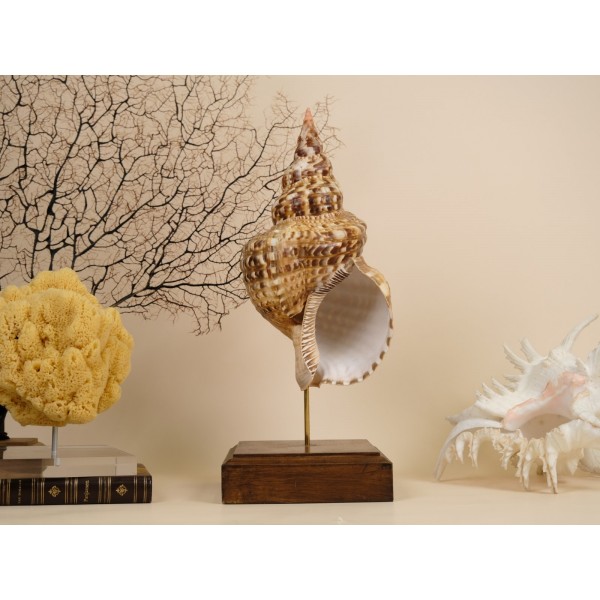Marine life dome
A colorful marine glass dome displaying an Acropora humilis coral, two Sugar Sea stars, two Alphonso Sea urchins, one purple sea urchin, two white knobbed urchins and two Mithrodia clavigera.
Beautiful decor piece for sea lovers!
| close |
This shop uses cookies to improve your experience on our website. |
Reference: N564
A great Charonia variegata from Brazil, big size, perfect pattern, seldom seen like this.
Displayed in a natural brown wood base.
Dimensions: 44 cm x 21 cm // Base: 18 cm x 18 cm x 5 cm
Weight: 1,8 Kg

A great Charonia variegata from Brazil, big size, perfect pattern, seldom seen like this.
Displayed in a natural brown wood base.
A colorful marine glass dome displaying an Acropora humilis coral, two Sugar Sea stars, two Alphonso Sea urchins, one purple sea urchin, two white knobbed urchins and two Mithrodia clavigera.
Beautiful decor piece for sea lovers!
Fantastic Spondylus croceus attached naturally in a dead coral base, from Olango Island, Cebu - Philippines.
Displayed in black granite socket.
An exceptional specimen of pinna nobilis, from Greece, in a black lacquered wood frame .
The specimen came from a old collection, today is impossible to get this size specimen.
One of a Kind decor piece!
Four Spondylus imperialis in a black wood glass frame.
Beautiful specimen collected by divers in 20 m deep of Jetafe, Bohol Isl. - Philippines
Vertical branch black Gorgonian in a black lacquered wood base, these medium sizes Gorgonia have a special shape and are taken by divers from Manado, North Sulawezi - Indonesia.
Nautilus pompilius - nowadays is a protected specimen, this is why it is supplied with CITES.
This is a great chance to get one!
Syrinx aruanius - Australian Trumpet shell in a dark brass base.
It's a species of extremely large sea snail measuring up to 91 cm long and weighing up to 18 kg. Shells over 50 cm are now impossible to obtain, specially in good condition. It is a marine gastropod mollusk in the family Turbinellidae, and is the only species in the genus Syrinx.
Superb pair of Hexaplex cichoreus from Balicasag, Philippines.
This intricated species is very variable in pattern and color, along the years we have had exceptional pieces, these ones are of great beauty.
Mounted in a black lacquered wood base.
Megabalanus tintinnabulum, from Philippines, in a green high gloss wood base.
Megabalanus colonies can reach big size groups, they live attached to rocks and dead coral in watched areas, sometimes attached in boats.
That is the reason why this species can be found in all Indo-Pacific but also in some areas of South Atlantic. Due to the incredible forms and colors they make excellent bizarre decor items.
Nine Gorgonocephalus specimen showing several variations displayed in a glass vitrine with black lacquered wooden base.
Gorgonocephalus - Astrospartus mediterraneus is a fantastic deep sea starfish.
These ones have been taken from a deep of 90 meters of Capo Vado, Savona Italy. It is necessary a special technique to dry and to keep it in a perfect shape, turning it a highly decorative and curious species. Sometimes they are attached to sponges and deep water corals.
This species habits until deeps of 800-900 meters.
An outstanding unique dramatic piece, handmade by One of a Kind.
Xenophora pallidula with glass sponge attachments in glass vitrine.
This particular species sometimes can be found with some spectacular attachments, in this case a big size glass sponge among many other deep water shells.
This specimen was found in Punta Engano - Philippines in 1993 from the late Emmanuel G. de Suduiraut.
Three pairs of beautiful cutted and polished Nautilus pompilius in a new glass vitrine with dark grey lacquered wood base and a high tech led illumination system.
Unique decor piece, designed by One of a Kind.
Alfonso Sea urchin and White Knobbly Sea urchins tower in brown granite base.
From Madagascar, a different decor piece!
Beautiful marine composition, looking like big mushrooms, made with shark vertebrae, from Madagascar and Scottish sea urchins, from North sea in a black lacquered wood base.
The two valves of a giant Acesta philippinarum, very rare, perfect condition in a pair of black lacquered wood pedestals.
These came from deep water, in tangle nets - from Balicasag island, Philippines.
This stunning Victorian-style table tray features two large valves of Pecten subnodosus, a species of scallop commonly known as the Giant Lion's Paw. Native to the Pacific and Gulf of California coasts of the Baja California Peninsula, Mexico, extending southward to the western coast of Peru. These specimens originate from Baja California, USA. This species is edible.
Mounted in a Victorian style with one Carnelian cabochon and four Amethyst cabochons, all set in a handmade dark brass base.